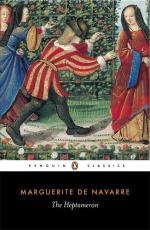3 Genin’s Nouvelles Lettres, &c., p. 189.
This was not her only motive in going to Cauterets apparently, for in a letter to Duke William of Cleves, her daughter’s husband, dated April 1541, she states that as she is suffering from a caterre which “has fallen upon half her neck,” and compels her to keep her bed, the doctors have advised her to take “the natural baths,” and hope that she will be cured by the end of May, providing she follows all their prescriptions.(1)
1 A. de Ruble’s
Mariage de Jeanne d’ Albret,
Paris, 1877, p. 86,
et seq.
That this visit to Cauterets left a deep impression upon the mind of Margaret is evidenced by the work upon which her literary fame rests. The scene selected for the prologue of the Heptameron is Cauterets and the surrounding country; still it is evident that the book was not commenced upon the occasion referred to, for in the prologue Margaret alludes to historical events which took place in 1543 and 1544, and she speaks of them as being of recent occurrence at her time of writing. Now we know that in April 1544 she met her brother at Alencon, and made a long stay in the duchy, and the probability is that she commenced the Heptameron at that time. It was the work of several years, penned in a desultory style whilst Margaret was travelling about her northern duchy or her southern kingdom. Like all persons of high station, she journeyed in a litter, and Brantome informs us that her equipage was a modest one, for “she never had more than three baggage-mules and six for her two litters, though she had two, three, or four chariots for her ladies.” (1) Brantome—who it may be mentioned was brought up at Margaret’s Court under the care of his grandmother, Louise de Daillon, wife of Andrew de Vivonne, Seneschal of Poitou—also states that the Queen composed the Heptameron mainly “in her litter, while journeying about, for she had more important occupations when she was at home. I have thus heard it related by my grandmother, who always went with her in her litter as her lady of honour, and held the escritoire with which she wrote, and she set them (the stories) down in writing as speedily and skilfully as if they had been dictated to her, if not more so.” (2)
1 Lalanne’s OEuvres de Brantome, 1875, vol. ii. p. 214.
2 Ibid., vol. viii. p. 226.
In 1545 and 1546 we find Margaret in Beam, whence she addresses New Year epistles to her brother expressing her sorrow at being separated from him. In the spring of the latter year she visits him at Plessis-les-Tours. The King of France—contrary to all tradition—enjoys at this period as good health as the most robust man in his kingdom.(1) In 1547 Margaret repairs to a convent at Tusson in the Angoumois to spend Lent there, and soon afterwards is despatching courier after courier to the Court at Rambouillet for news of Francis, who




